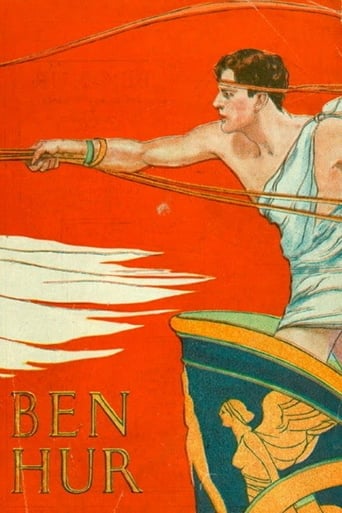smashtheelder
It's true that film makers were still feeling their way in the 1900s, but that's no excuse for a film to be boring now. Look at "Le voyage dans la lune" or "The Great Train Robbery", both of which came several years before Ben-Hur 1907. Even "Sherlock Holmes Baffled", a silly trick film from 1900, is still amusing.The story is fragmented and would only make sense if you already knew it. (Which, to be fair, was likely at the time; Ben-Hur was as popular then as Harry Potter is now.) The chariot race is pathetic, being nothing more than the horses passing the camera several times until the movie ends. It would have been difficult to film an exciting chariot race within the limitations of the time, but this was not a good workaround. The only saving grace of this movie is that, like others of the time, it is short, barely ten minutes long.Ben-Hur 1907 is proof that crappy cash-ins have been around even in the early days of cinema. We are fortunate it has survived, if only because that prevents any mystique from being attached to it, as has happened with films like "The Great Gatsby (1925)".
Horst in Translation ([email protected])
Most people know Lew Wallace's tale of Ben Hur mostly from the movie starring Charlton Heston, but there are other versions out there too, several of them considerably older. This one here may be the first and it was released shortly after the death of the aforementioned author almost 110 years ago. Unfortunately, if you don't know the story, you will have absolutely no clue what is going on. It is a black-and-white silent film and intertitles are basically non-existent here, which makes it impossible to understand the plot. This is also why I cannot recommend this one. There are films from the 19th century that are considerably better than this one and the only area where it sort-of delivers are the costumes I guess. Thumbs down. Don't watch.
Michael_Elliott
Ben Hur (1907) ** (out of 4) The first version of the classic novel has a bit of history behind it but the actual film doesn't hold up. We get Herman Rottger playing Ben Hur, the man who becomes a slave and will eventually revolt and go up against Messala (William S. Hart). For starters, if anyone tries comparing this to the 1925 or 1959 versions then they're really cheating all three films. This is a 13-minute short so there's a lot to get crammed in here and of course the story is going to have to bounce around and not spend too much time on one plot point. With that said, the end result here is pretty disappointing because none of the apparent five directors knew how to build any real suspense or to make us care about anything we're seeing. We can never really get into the actual story and it's hard to care for any of the characters. Another problem is that the film really doesn't even appear to try and do anything overly special. We get some very impressive costumes but that's about it. This movie remains entertaining as a curio if you've seen what films would follow. On the historic side, this was the first film to end up in court due to copyright violations so I guess all authors has this film to thank for filmmakers not being able to take their work without credit.
reptilicus
BEN HUR might seem an ambitious undertaking for the early days of the cinema but consider that by 1899 there had already been 2 filmed versions of H. Rider Haggard's SHE and 1 of Oscar Wilde's THE PICTURE OF DORIAN GRAY. The early 1900's saw early attempts at A TALE OF TWO CITIES, THE COUNT OF MONTE CRISTO and or course BEN HUR. The costumes are nice but I doubt the painted canvas backdrops convinced anyone even way back in 1906. The story is intact, as much as a single reel (12 minutes) will allow. In this version Hur does not get sent to the galleys; it is the chariot race which will decide if he is condemned as a criminal or not. Oh yes, even this early version has a chariot race and it is set up to be the highpoint of the picture. Alas, don't expect much in the way of special effects. This race has only two participants, Ben Hur and Massala, and they simply run their chariots around and around a camera which never moves. We all know how the story ends. The panorama, or "pan" shot was in use as early as 1896 when it was invented by an Venitian gondolier named Promio who put a camera in his boat to take a long shot of Venice as seen from the canal. The closeup was around in 1907 as evidenced by a short called MR. HURRY-UP OF NEW YORK but neither accomplishment is seen in this film. It's almost a certainty that audiences were easier to please then, at least they were for a little while, and for its time this version of BEN HUR did indeed offer more than the average one reel short. We are lucky that this version, and so many other early films survive to show us that filmmakers even back then were willing to take chances. At the time nobody knew that a fellow named D.W. Griffith was waiting in the wings gathering experience and developing some ideas of his own.

